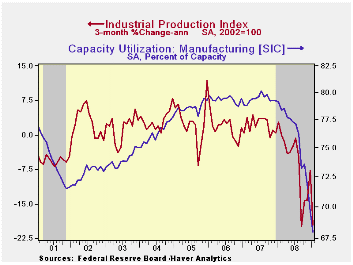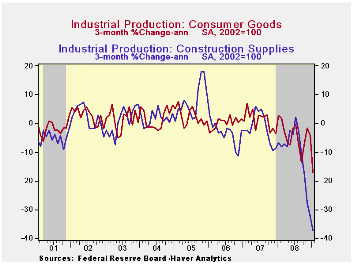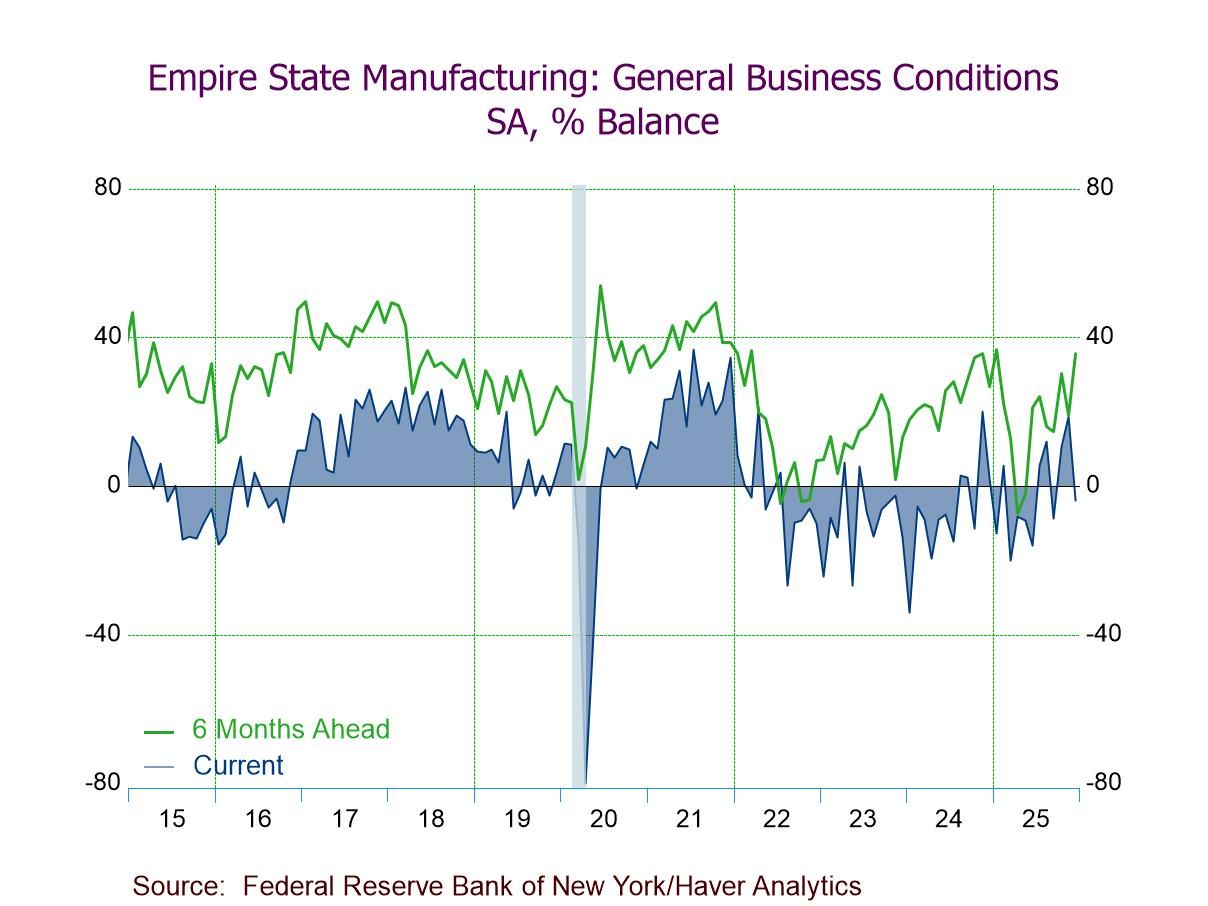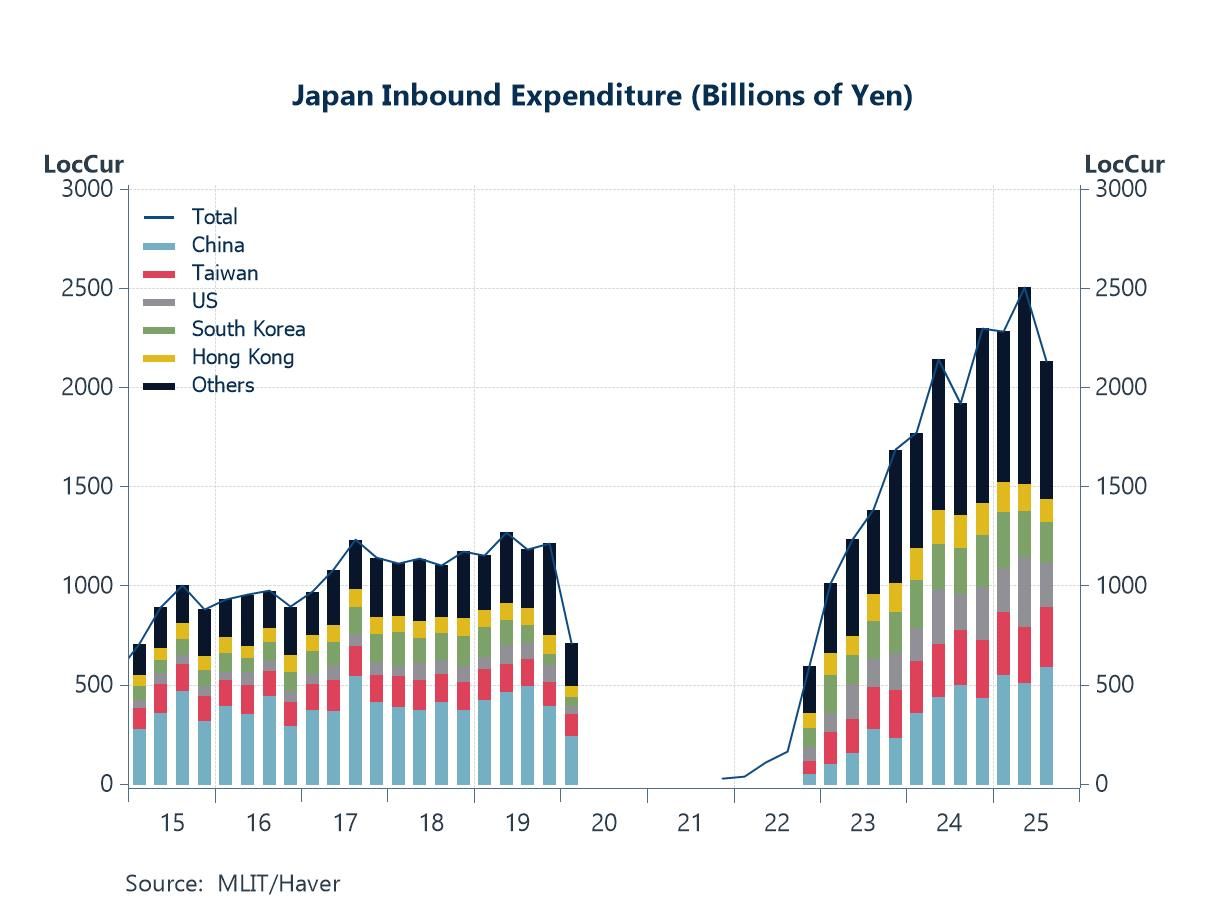 Global| Feb 18 2009
Global| Feb 18 2009U.S. Factory Output Down Sharply Again in January; Off 10.0% Y/Y
by:Tom Moeller
|in:Economy in Brief
Summary
The U.S. factory sector remained severely depressed last month. Industrial production during January fell 1.8% after the 2.4% drop during December which was revised deeper from the initial report. Last month's decline about matched [...]

The U.S. factory sector remained severely depressed last month. Industrial production during January fell 1.8% after the 2.4% drop during December which was revised deeper from the initial report. Last month's decline about matched Consensus expectations for a 1.5% decline.
Year-to-year output is off 10.0%, the sharpest decline since early 1975. Reduced domestic demand, inventory cutbacks and recessions abroad have combined to lower overall U.S. production like it never has. And downward momentum has gained steam.
An acceleration in that downward momentum is apparent in the 19.7% annual rate of output decline during the last three months. But that understates the severity of the shortfall because mining and utility output is up. In the factory sector alone, output is off at a 26.7% annual rate during the last three months versus a modest 2.6% drop during all of last year.
Output of construction supplies has fared the worst. A 3.4% drop in production last month lowered the three-month rate of decline to 37.3% following the 6.2% drop during all of last year. Output of consumer goods fell 1.8% last month and the three-month rate of change accelerated to -17.2%. That was accentuated by a 77.5% three-month annual rate of decline in the output of motor vehicles & parts. That came on top of a 14.5% decline during all of last year. Outside of the auto sector, output also was hard hit. Production of furniture fell at a 28.0% during the last three months while apparel output fell at a 29.2% rate. Production of business equipment resumed its downward trend last month with a 3.7% decline which reversed two months of increase.
Industrial production in the high-tech sector fell 3.2% last month capping a 12.8% year-to-year decline. Less that downdraft in high tech, overall industrial production fell 2.6% last month and the annual rate of change of -13.7% was the weakest since 1975.
Outside of output declines in autos and high tech, total production which includes mining and utilities fell 0.9% last month and the three-month annual rate of decline accelerated to -13.9%. The rate of decline in factory sector output less these two sectors accelerated to -20.7%.
Excess capacity continued to grow last month. Capacity utilization fell to 72.0%, the lowest level since 2003. Utilization in the factory sector dropped even harder to 68.0% from a peak near 80% back in 2007. Capacity in the factory sector increased a somewhat reduced 1.4% (y/y).
The industrial production data are available in Haver's USECON database.
The Credit Crunch of 2007-2008: A Discussion of the Background, Market Reactions and Policy Responses from the Federal Reserve Bank of St. Louis can be found here.
| INDUSTRIAL PRODUCTION (SA, %) | January | December | Y/Y | 2008 | 2007 | 2006 |
|---|---|---|---|---|---|---|
| Total Output | -1.8 | -2.4 | -10.0 | -1.8 | 1.7 | 2.2 |
| Manufacturing | -2.6 | -2.9 | -12.8 | -2.5 | 1.7 | 2.4 |
| Consumer Goods | -1.8 | -2.0 | -7.9 | -2.2 | 1.7 | 0.3 |
| Business Equipment | -3.7 | 2.4 | -10.9 | -1.3 | 3.3 | 10.4 |
| Construction Supplies | -3.4 | -4.1 | -16.7 | -6.2 | -2.5 | 2.2 |
| Utilities | 2.7 | -0.2 | 1.4 | 0.5 | 3.3 | -0.6 |
| Capacity Utilization | 72.0 | 73.3 | 81.0 (Jan.'08) | 78.2 | 81.0 | 80.9 |
Tom Moeller
AuthorMore in Author Profile »Prior to joining Haver Analytics in 2000, Mr. Moeller worked as the Economist at Chancellor Capital Management from 1985 to 1999. There, he developed comprehensive economic forecasts and interpreted economic data for equity and fixed income portfolio managers. Also at Chancellor, Mr. Moeller worked as an equity analyst and was responsible for researching and rating companies in the economically sensitive automobile and housing industries for investment in Chancellor’s equity portfolio. Prior to joining Chancellor, Mr. Moeller was an Economist at Citibank from 1979 to 1984. He also analyzed pricing behavior in the metals industry for the Council on Wage and Price Stability in Washington, D.C. In 1999, Mr. Moeller received the award for most accurate forecast from the Forecasters' Club of New York. From 1990 to 1992 he was President of the New York Association for Business Economists. Mr. Moeller earned an M.B.A. in Finance from Fordham University, where he graduated in 1987. He holds a Bachelor of Arts in Economics from George Washington University.






